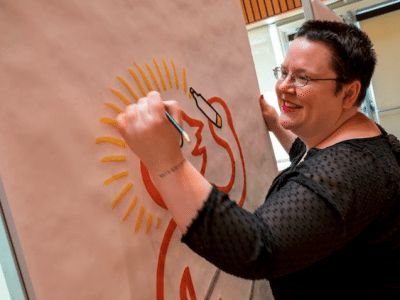Business school seems like an unlikely place for a dancer, but the University of Chicago’s Booth School of Business brought John Michael Schert as a visiting artist in 2013. Schert began his career as a dancer with the American Ballet Theatre and ended up working in arts administration.
During his two-year residency at Chicago Booth, he conducted research and training programs on how the creative process as practiced by artists applies to other aspects of the world.
That includes business.
Schert published a summary of his work in a recent issue of the Chicago Booth Review. A key point is that creative fields use more transferrable skills than one might realize. For example, dancers learn to read the cues of those sharing the stage, as well as the response of the audience. They learn to become comfortable with things that are different and unusual to the average person.
Creativity should not be confused with artistic skill, said Brandy Agerbeck. She is a graphic facilitator and author of The Idea Shapers, which covers drawing techniques for working with ideas.
“someone thinks, ‘Oh, I can’t paint, so I’m not creative,’” she said. “That specifically is creating a painting from paint, brushes and canvas. Creativity is much more broad. It includes resourcefulness, problem solving, seeing an old problem from a new angle.”
Agerbeck said that the only people who are not creative are those who are complacent and lack curiosity.

Entrepreneurs usually have deep reserves of creativity, but they get overlooked in the press of meeting with clients, managing cash flow and keeping up with email. How do you bring that latent creativity up?
Schert focuses on working with things that you have not explored, even if it is uncomfortable. If you try new things without thinking of success as an end goal, you will be able to stretch your brain. New ideas, free of preconceived notions, may pop up that will be useful in your business or elsewhere in your life.
“Sitting with discomfort,” as he put it, is a way to be open to ideas that might not come up in other situations.
Related: How to Get Over a Creativity Slump In Your Business
For many people, drawing is one of those uncomfortable experiences. Agerbeck recommends taking out paper and markers to explore ideas.
“Instead of a list, you’re making fast, messy drawings that can go in any direction on the page,” she said. “Thinking visually and spatially helps tackle complex problems by seeing how interdependent pieces fit together.”
Many entrepreneurs are used to succeeding at challenges, and they often like visible signs of progress. They might be turned off by a scrawling sketch or a clumsy dance, that’s the point, according to Agerbeck.
“You’re making meaning for yourself,” she said. “Even messy drawings create clarity.”
No one has to see what you create, unless you want them to. The practice is enough to help you refresh your innate creativity.
Some of your creative exploration may be for your own personal development. It can be a way of getting out of a rut and coming up with ideas for your work and life. Or, you could apply them to specific work problems. Think of songs to help you come up with a new slogan, or use watercolors to experiment with new logo designs. It’s all about doing something different.
Related: Sign up to receive the StartupNation newsletter!
If you do like what you create, Agerbeck said you can always bring in a professional to improve it. Your loose sketch can be turned over to a designer for refinement.
“If you simply think, ‘Oh, I’m not creative. I better get someone who is,’ you’re robbing yourself of the thinking and problem solving for the business that you know best: your own,” she said.






